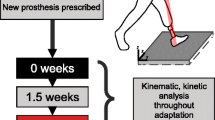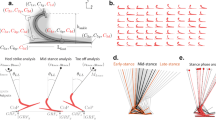Abstract
An effective design method is suggested for a flexible keel design for energy-storing prosthetic feet (ESPF). The basic, two-dimensional shape of the keel is based on anthropometric data and normal gait analysis available in the literature. Cost function is defined for the performance evaluation of the keel. Five factors and five levels of their effect on the performance of the keel are established. By use of an orthogonal array table, 25 trials of dynamic simulations of prosthetic walking are designed, from among 3125 possible combinations, dramatically reducing the number of total simulations needed to examine sufficiently the contribution of each factor to cost function. A prosthetic walking model is built, and a dynamic simulation of prosthetic walking is performed using the finite element method. The contribution of each factor to cost function is investigated by an analysis of variance (ANOVA), and the average main effects of factors for cost function are calculated. The optimum combination of factor levels is obtained by minimisation of cost function. To examine the structural safety of the keel, the deformation and stress distribution of the keel are investigated by static analysis, and failure indices are calculated by three failure criteria. Finally, the optimum flexible keel is designed with increased energy storage capacity, without failure, and suitable for more active prosthetic walking; the recoverable strain energy stored in the optimum ESPF keel is 25.8 J.
Similar content being viewed by others
References
Allard, P., Trudeau, F., Prince F., Dansereau, J., Labelle, H., andDuhaime, M. (1995): ‘Modelling and gait evaluation of asymmetrical-keel foot prosthesis”,Med. Biol. Eng. Comput. 33, pp. 2–7
Arya, A. P., Lees, A., Nirula, H. C., andKlenerman, L. (1995): ‘A biomedical comparison of the SACH, Seattle and Jaipur feet using ground reaction forces’,Prosthet. Orthot. Int.,19, pp. 37–45
Barth, D. G., Schumacher, L., andSienko T. S. (1992): ‘Gait analysis and energy cost of below-knee amputees wearing six different prosthetic feet’,J. Prosthet. Orthot.,4, pp. 63–75
Casillas, J. M., Dulieu, V., Cohen, M., Marcer, I., andDidier, J. P. (1995): ‘Bioenergetic comparison of a new energy-storing foot and SACH foot in traumatic below-knee vascular amputations’,Arch. Phys. Med. Rehabil.,76, pp. 39–44
Czerniecki, J. M., Gitter, A., andMunro C. (1991): ‘Joint moment and muscle power output characteristics of below knee amputees during running: the influence of energy storing prosthetic feet’,J. Biomech.,24, pp. 63–75
Drillis, R., andContini, R. (1966): ‘Body segment parameters’. Report 1163-03, Office of Vocational Rehabilitation, Department Health, Education & Welfare, New York
Ehara, Y., Beppu, M., Nomura, S., Kunimi, Y., andTakahashi, S. (1993): ‘Energy storing property of so-called energy-storing prosthetic feet’,Arch. Phys. Med. Rehabil.,74, pp. 68–72
Jones, R. M. (1975): ‘Mechanics of composite materials’ (McGraw Hill, New York)
Lehmann, J. F., Price, R., Boswell-Bessette, S., Dralle, A., andQuestad, K. (1993): ‘Comprehensive analysis of dynamic elastic response feet: Seattle Ankle/Lite Foot versus SACH foot’,Arch. Phys. Med. Rehabil.,74, pp. 853–861
Leone, D. J. (1987): ‘A structural model for molded thermoplastic ankle-foot orthoses’,J. Biomech. Eng.-T. ASME,109, pp. 305–310
Molen, N. H. (1973): ‘Energy/speed relation of below-knee amputees walking on a motor-driven treadmill’,Int. Z. Angew. Physiol.,31, pp. 173–185
Postema, K., Hermens, H. J., Vries, J. D., Koopman, H. F. J. M., andEisma, W. H. (1997): ‘Energy storage and release of prosthetic feet part 1: biomechanical analysis related to user benefits’,Prosthet. Orthot. Int.,21, pp. 17–27
Postema, K., Hermens, H. J., Vries, J. D., Koopman, H. F. J. M., andEisma, W. H. (1997): ‘Energy storage and release of prosthetic feet part 2: subjective ratings of 2 energy storing and 2 conventional feet, user choice of foot and deciding factor’,Prosthet. Orthot. Int.,21, pp. 28–34
Rose, J. andGamble, J. G. (1994): ‘Human walking’, 2nd edn. (Williams & Wilkins, Baltimore)
Ross, P. J. (1996): ‘Taguchi techniques for quality engineering’ (McGraw-Hill, New York)
Roy, R. K. (1990): ‘A Primer on the Taguchi method’ (Van Nostrand Reinhold, New York)
Winter, D. A. (1979): ‘Biomechanics of human movement’ (John Wiley & Sons, New York)
Wagner, J., Sienko, S., Supan, T., andBarth, D. (1987): ‘Motion analysis of SACH vs. Flex-Foot in moderately active below-knee amputees’,Clin. Prosthet. Orthot.,1, pp. 55–62
Winter, D. A. (1983): ‘Energy generation and absorption at the ankle and knee during fast, natural and slow cadences’,Clin. Orthop. Relat. Res.,197, pp. 147–154
Winter, D. A., andSienko, S. E. (1988): ‘Biomechanics of below knee amputee gait’,J. Biomech.,21, pp. 361–367
Author information
Authors and Affiliations
Corresponding author
Rights and permissions
About this article
Cite this article
Jang, T.S., Lee, J.J., Lee, D.H. et al. Systematic methodology for the design of a flexible keel for energy-storing prosthetic feet. Med. Biol. Eng. Comput. 39, 56–64 (2001). https://doi.org/10.1007/BF02345267
Received:
Accepted:
Issue Date:
DOI: https://doi.org/10.1007/BF02345267




